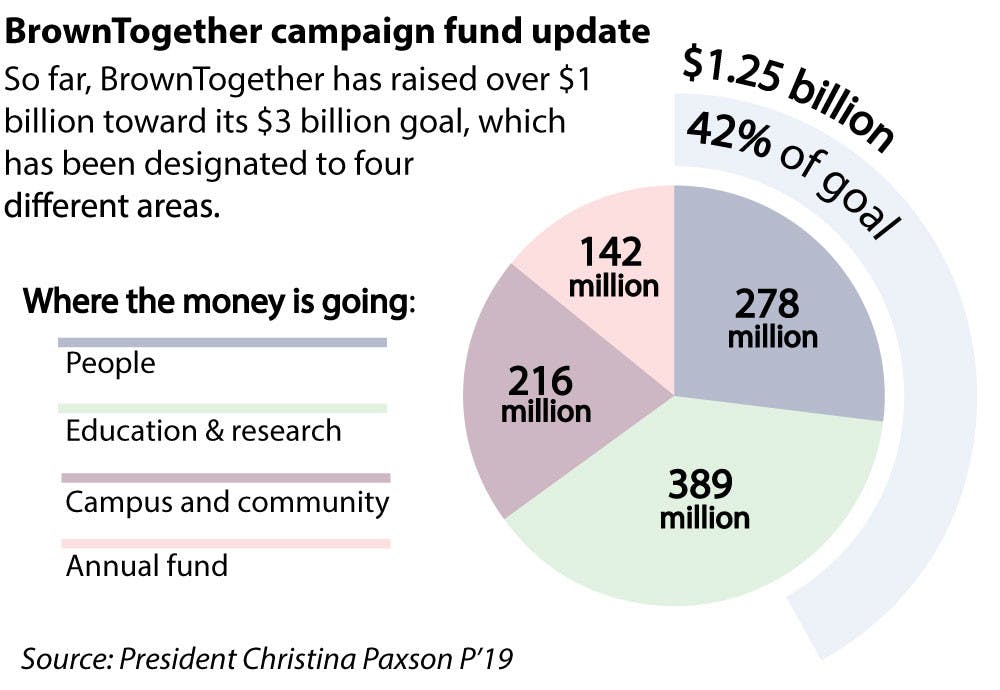The BrownTogether campaign has raised $1.25 billion in gifts and pledges — about 40 percent of a $3 billion goal — in over a year since its launch in October 2015, said President Christina Paxson P’19.
Fundraising has been concentrated into four different areas: $278 million has been raised for investments in people, such as undergraduate financial aid and endowed professorships; $389 million for education and research; $216 million for campus and the community and $142 million for the Brown Annual Fund, Paxson said.
About $225 million has not been allocated toward any of the four categories, she added. Termed “white space” by Paxson, some of these unallocated funds will go toward future, unspecified goals. The rest will eventually be allocated by the campaign’s donors depending on their preferences, Paxson added.
The campaign is currently ahead of schedule with over $300 million raised last year and $293 million raised the year before. If growth continues at its current rate, Paxson suggested the campaign could either finish ahead of schedule or grow beyond its goal of $3 billion.
Though the campaign has raised $1.25 billion in gifts and pledges, the University has received an additional $790 million in cash that it can spend immediately, Paxson said.
There are safeguards in place to ensure that the University does not spend money it has not yet received, Provost Richard Locke said. Usually when donors make a pledge, they fulfill that pledge within five years, Locke added.
Though the campaign has no scheduled end date, Paxson hopes to grow the University’s fundraising capacity from about $250 million to about $300 million raised each year, Paxson said. “I had originally hoped … that we could average about $300 million a year over seven years,” Paxson said.
Some goals have already seen marked success, Paxson said, highlighting funds raised for the athletics department, the Nelson Center for Entrepreneurship and the nearly completed School of Engineering building.
For the “people” fundraising bucket, Paxson said the campaign has raised about $79 million for endowed undergraduate financial aid and funds for 37 endowed faculty positions. She hopes the campaign will produce 117 new endowed chairs, which require about $400 million.
Funds for brain science and public health have both made progress in the “education and research” category, Paxson said. Over $30 million has been raised for Dean of the College educational initiatives, which include programs such as BrownConnect and various opportunities in the Swearer Center for Public Service, she said. About $25 million has also been raised for research and education at the Alpert Medical School, Paxson added.
We are “making sure we are doing cutting edge research,” said Paula McNamara ’84, an Annual Fund fundraising co-chair. Cambridge, Massachusetts “is the mecca, and we want to be more competitive” compared to the peer institutions located there, she said. The fund will help to attract the best people to do research, which is incredibly important for remaining a competitive institution, she added.
The engineering building, currently under construction, and funds for the athletics facilities have been the primary targets of the “campus and community” bucket, Paxson said. “Completing fundraising for a performing arts center will be an area of focus for the next year,” she added.
“I cannot overstate the importance of the Annual Fund,” Paxson said. The Annual Fund currently brings about $36 million a year, Paxson said, adding that she hopes to raise that number to $50 million annually.
Incorporating the goals of the Diversity Action and Inclusion Plan, which is funded by the BrownTogether campaign, has not been difficult because many of the goals outlined in the DIAP were already included in the Building on Distinction plan, Paxson said. The BrownTogether campaign already included goals for increasing diversity and graduate education and expanding the Center for the Study of Race and Ethnicity in America and the Center for Study of Slavery and Justice, she added.
The new fundraising priorities created by the DIAP include the First-Generation and Low-Income Student Center and the Native and Indigenous Studies Initiative at Brown, which the “white space” provided funding for, she added.
“The campaign is going much better than I had initially anticipated,” Locke said. Locke is the chair of the Strategic Coordinating Committee, which meets every three weeks to evaluate gifts and assess whether they meet the operational goals for the campaign, as outlined by the Building on Distinction plan. Many of the people involved in strategic planning are also involved in budget forecasting to ensure that the budget accounts for new endowments and donations, Locke said.
The messaging for the campaign centers around the branding of BrownTogether, said Jerome Vascellaro ’74 P’07, former vice chancellor of the University’s corporation and a campaign co-chair. “I think (the campaign) resonates with today’s world because problems are not monolithic — they’re integrated” and global, Vascellaro said. “Supporting Brown is supporting that ethos and culture.”





